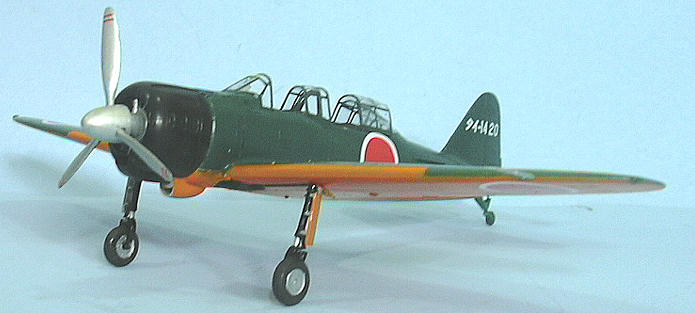
Hasegawa 1/48 A6M2-K Model 11 trainer
| KIT #: | 09855 |
| PRICE: | $44.95 SRP |
| DECALS: | Three options |
| REVIEWER: | Tom Cleaver |
| NOTES: | Limited reissue with new parts |

| HISTORY |
As the Japanese Navy attempted to expand the ranks of its aviators
following the outbreak of the Pacific War, standards were lowered from what they
had been only a year before. Pilots
were graduating from flight school without the experience their predecessors
had, and flying high performance aircraft like the Zero was a difficult
transition for many. As a result,
the Japanese Navy formulated a requirement for a two-seat transition trainer to
allow new pilots the chance to learn about the Zero with an experienced
instructor at their side.
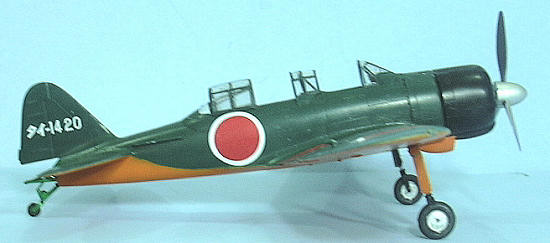 A two-seater was developed by the Imperial Japanese Navy’s Flight
Technology Center No. 21 - the A6M2-K Model 11, modified from the Model 21
fighter. The first conversion prototype flew in November 1942, with the first
production trainers coming off the production line in January 1943.
A two-seater was developed by the Imperial Japanese Navy’s Flight
Technology Center No. 21 - the A6M2-K Model 11, modified from the Model 21
fighter. The first conversion prototype flew in November 1942, with the first
production trainers coming off the production line in January 1943.
The Zero trainer used the same Sakae 12 engine, with the airframe
identical except that the cockpit was shifted forward to maintain the center of
gravity with an instructors cockpit behind the standard cockpit.
Two strakes were placed on the rear fuselage ahead of the horizontal
stabilizers for spin stabilization.
The student’s forward cockpit did not have a sliding canopy. A sturdier,
lighter, heavy-duty tail wheel replaced the small solid rubber tire of the
fighter. The two 20mm cannon were
removed from the wing to save weight, while the 7.7mm machine guns in the
fuselage were retained for gunnery training.
Over 500 A6M2-Ks were produced until production ceased in July 1945. In addition to its use by flying schools, many front line units kept at least one trainer available for proficiency training as pilot standards continued to deteriorate through the war.
| THE KIT |
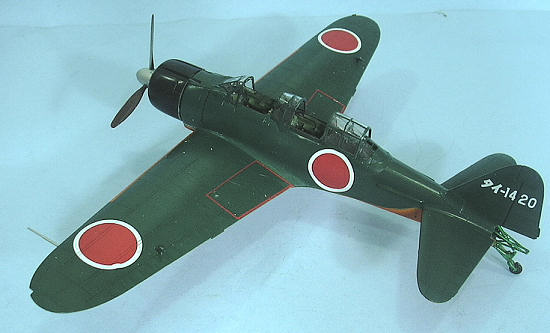 Hasegawa has “owned” the Zero since they first released their A6M2 Model
21 in the mid-1990s. Over the years
since, they have managed to release models of every sub-type of
Hasegawa has “owned” the Zero since they first released their A6M2 Model
21 in the mid-1990s. Over the years
since, they have managed to release models of every sub-type of
The parts are standard Hasegawa: crisp, with enough detail in the cockpit that one will only want to add seatbelts. The decals provide markings for three different A6M2-Ks, and there are sufficient serial number decals one could attempt just about any A6M2-K you have a photo of.
| CONSTRUCTION |
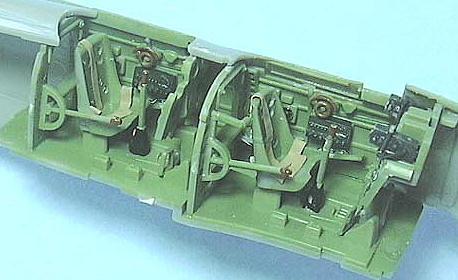 Building any of the Hasegawa Zeros is easy, since they are well-designed
and everything fits. The same was
true here with this project.
Building any of the Hasegawa Zeros is easy, since they are well-designed
and everything fits. The same was
true here with this project.
I began by painting everything.
This was considerably easier than was the case with any previous Zero
model, due to the fact that Tamiya has released new color paints, which include
“Mitsubishi Cockpit Green,” which Tamiya identifies as XF-71 “Cockpit Green
(IJN)”. The parts were painted with
this color while still on the sprues.
I then applied the instrument decals.
When this was done, I put Eduard 1/48 IJN seatbelts on the seats, and
then proceeded to assemble the cockpit, which presented no problems.
| COLORS & MARKINGS |
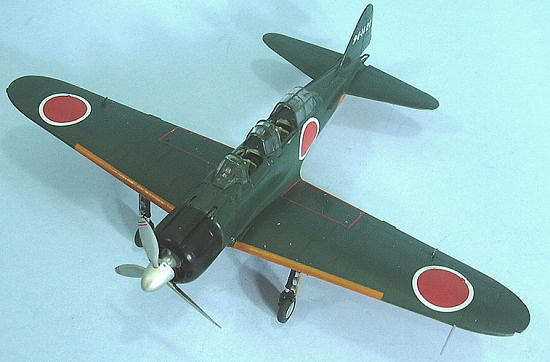 Painting:
Painting:
After masking off the canopy with Scotch transparent tape, the model was
painted with the new Tamiya XF-70 “Dark Green 2 (IJN)” which is “Mitsubishi
Green” on the upper surfaces, and Tamiya Orange on the lower surfaces, with the
demarcation line masked off. The cowling was painted Tamiya “Semi-Gloss Black,”
as was the main gear legs. The
wheel well and the tailwheel and internal tail structure was first painted
Tamiya “Flat Aluminum,” and then Tamiya “Glear Green” to get the “Green Aotake”
color.
Decals:
I used the kit decals to create the airplane shown on the box art.
The new Hasegawa decals are very thin and go on without problem under a
coat of Micro-sol.
| FINAL CONSTRUCTION |
I gave the model an overall coat of Xtracrylix Flat Varnish.
When that was dry, I unmasked the canopy and installed the sliding
section in the open position.
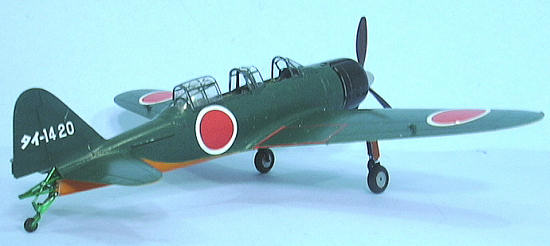 I attached the landing gear, assembled the engine and attached that and
the cowling, followed by the prop.
The instructions say that these aircraft, being operated by training schools,
were kept in very clean condition, so I did not weather the model further.
I attached the landing gear, assembled the engine and attached that and
the cowling, followed by the prop.
The instructions say that these aircraft, being operated by training schools,
were kept in very clean condition, so I did not weather the model further.
| CONCLUSIONS |
This is definitely a kit I did not think I would see released as other
than an aftermarket conversion set from some “garage manufacturer.”
Hasegawa is to be commended for doing this.
They might even release an A6M5-K, which would only take their putting
these new sprues in their A6M5a kit.
With its distinctive orange paint schemes, the Zero trainer makes a nice
addition to any collection of Zero fighters.
I suspect they didn’t make many of these, so if you run across one, pick
it up because there aren’t likely to be more where it came from, though I do
note that Hannant’s shows them in stock.
June 2009
If you would like your product reviewed fairly and quickly, please contact me or see other details in the Note to Contributors.